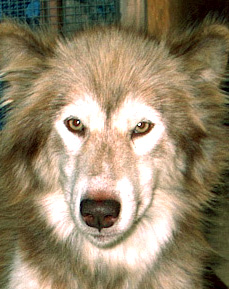Table of Contents
*
Featured Inuit Dog Owner: Merv Ehrich
*
Jubilee Medal Awarded to ISDI Co-Founder
*
Blue Eyes in Norwegian Greenland Dogs
*
ISD Enthusiasts Speak out on Blues Eyes
*
ISDI's Official Stand on Blue Eyes
*
Mountie, Alouette and Moose
*
Following Nanuk's Tracks
*
The Qitdlarssuaq Chronicles, Part 1
*
News Briefs:
New ISDI Scandinavia Web Site
Atanarjuat Update
Dog Teams in Iqaluit
Grammar Lesson
ISDs in Museum Exhibit
*
Poem: Lost Travellers
*
Book Review: first Nations.... first Dogs
*
ISD Enthusiast's First Novel Published
*
IMHO: Seeking to Answer the Wrong Question
Navigating This
Site
Index of articles by subject
Index
of back issues by volume number
Search The
Fan Hitch
Articles
to download and print
Ordering
Ken MacRury's Thesis
Our
comprehensive list of resources
Talk
to The
Fan Hitch
The Fan
Hitch home page
ISDI
home page
Editor: Sue Hamilton
Webmaster: Mark Hamilton
Contents of The Fan Hitch Website and its publications are protected by international copyright laws. No photo, drawing or text may be reproduced in any form without written consent. Webmasters please note: written consent is necessary before linking this site to yours! Please forward requests to Sue Hamilton, 55 Town Line Rd., Harwinton, Connecticut 06791, USA or mail@thefanhitch.org

Nanertak, a three-year-old female Montcombroux photo
The Inuit Sled Dog International's
Official Stand
on the Issue of Blue Eyes in Inuit
Sled Dogs
prepared by ISDI Co-Founder, Geneviève Montcombroux
A lot of ink has been spilled lately in Norway over the issue of the Inuit Sled Dog's eye color. It is appropriate, therefore, that the Inuit Sled Dog International should reaffirm its position regarding the ISD standard.
In response to the Norsk Polarhund Klubb's acceptance of blue eyes in the Inuit Sled Dog, even though blue eyes were previously considered a fault, let us review some other eye standards. In Canada, the original Canadian Kennel Club breed standard listed eyes as "Dark, small and deep set." This standard was revised in 1978 to "The eyes are generally dark-colored, but hazel or yellow-colored will appear in the breed." No mention was made of blue because obviously there were no blue eyes in the breed.
The original standard of the FCI states that eyes are dark in color, but can be lighter according to the dog's coat. Light and dark cinnamon (also called red or brown) ISDs have amber eyes. The standard of the Kennel Club (UK) is unequivocable about the eye color: "Dark brown or tawny." under Greenland dog, and "Generally dark but hazel and yellow occur, depending on pigmentation. Never blue." under Canadian Eskimo Dog. The reference to "Blue eyes" appears for the first time in the 1988 The Canadian Kennel Club Book of Breeds under "faults". The only book on the ISD, The Canadian Inuit Dog: Canada's Heritage, states that "the eyes are never blue". Likewise, the Inuit Sled Dog International states clearly in its standard, posted on its website, that the ISD's eyes are never blue.
Before we go any further, we ought to establish that with the Greenland Dog and the ISD we are talking about one and the same breed. The Greenland Dog, or Grønlandshund, is an Inuit Dog originating from Greenland. Norway and most of the other European countries have Grønlandshunds. The people we now know as Inuit originated in central Siberia and migrated along the coast, across the Bering Straits into Alaska and Canada, then crossed Smith Sound into Greenland, all this over several centuries if not millennia. The best documented migration is that of the Thule civilization. These people had dogs, the ancestors of the present ISD. Historically, therefore, it is the same breed of dog whether it comes from Canada or Greenland.
The whalers, as early as the 18th century, were the first white people the Inuit saw. The whaling captains kept diaries and some described, often in great detail, the dogs that pulled the Inuit's sleds. These early references make no mention of blue eyes. Before the turn of the 20th century, the blue-eyed Siberian Husky had not appeared on the North American continent nor in Europe. It seems logical to think that if early arctic travelers had seen blue-eyed dogs they would have noted it, as it is a striking feature. Nowadays, people openly marvel at blue-eyed Siberians despite their being common.
The latter part of the 19th century and the early part of 20th were eras of great exploration by traders, adventurers, and missionaries. These early visitors documented their journeys with meticulous care. Many wrote books. Not a single explorer or missionary mentions seeing blue eyes in dogs, either in Greenland or Canada. Occasionally, there is a mention of "wolf eyes" which were obviously amber in color. As the Canadian North became settled, white people introduced domestic breeds of dogs into the Inuit settlements. This, along with the RCMP attempts at distribution of Siberian Huskies, was the beginning of the contamination of the ISD. The ISDI is not concerned with crossbred dogs. Dogs raised in the outpost camps by traditional hunters remained pure thanks to their isolation. None of them had blue eyes then, and none do to this day.
If the characteristic of blue eyes had occurred, either as the result of a genetic mishap or mutation, it would surely have been recorded in the Inuit's oral history, just as it would have found its way in the writings of explorers, ethnographers, and other travelers. In contrast, the occurrence of the merqujuq has been closely documented by these means.
The Inuit Sled Dog International stands firm on this
issue. The pure
Inuit Sled Dog, whether from Greenland or Canada, never
has blue eyes.
Editor's note: The Inuit Sled Dog International will be forwarding a copy of this issue of The Fan Hitch along with an official letter to both the Norwegian and Danish Kennel Clubs stating our position on blue eyes in the Greenland (and any other) Inuit Dog.